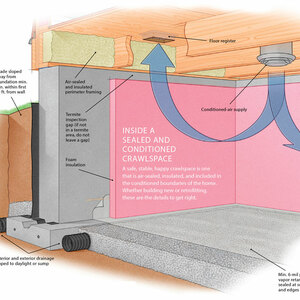My son just bought a condo where the previous owners applied plaster in 1/2″ thick swirls to complement a Mexican decor. It covers one dining area wall, goes around the corners on each end, around a closet and into the kitchen, on both ends of the backsplash and two walls behind the refridgerator!!
Any easy ideas for removing this stuff? A last option would be to apply new drywall although I am concerned about the look of thick end walls, and the fridge is already oversized and kicks into the walkway (it’s in a corner). If we did re-drywall would scraping out strips to embed 1×2’s and then screw the drywall to those work? Any better ideas?
Thanks, Krystyna


















Replies
Could you scrape off the high peaks and ridges and skim coat a smooth finish? Would you be able to rent a Porter Cable dustless drywall sander and using coarse paper (whatever grit is necessary) to smooth enough to skim coat?
Remodeling Contractor just outside the Glass City.
Quittin' Time
to apply new drywall
Just in case no one else said so--Welcome to BT.
Adding new DW is going to be about the same effort as demolishing the exisiting DW & plaster combo. I'm going to guess that who ever applied the plaster made sure it would "stick" (because Murphy was an optimistic remodeler <g>). That means, if you try to scrape the plaster off, it's taking the top layer off the DW--or the DW will be gouged up beyond all recognition. A half inch is a lot of sanding and is a lot of sticky, pernicious dust.
That's why I'd be tempted to visqueen (clear plastic polyethylene sheets) the room up, run a fan or vac to the outside to draw a slight negative pressure, and just gut out the DW plaster combo. But then, I have experience in demolition. But the demo dust, and the finish DW sanding wouldn't be half the dust from trying to bust out just the plaster.
But, that's my bias, others may disagree. I had to cope with a ceiling "plastered" in premixed joint compound once. Just the once. Give me a crick in the neck thinking about it . . .
When you said something about new drywall ... sounds like you meant to add a layer on top of what's already there. Not a good idea. None of the electrical outlets will fit, the base won't fir, and the door jambs will look funny. However, if you meant to remove the existing drywall down to the studs and apply new drywall, well that's probably the best method.
Whenever you are asked if you can do a job, tell'em "Certainly, I can!" Then get busy and find out how to do it. T. Roosevelt
I would try wetting it down with a deck sprayer (pressurized can weed sprayer ... same thing), and then scraping it off. I am guessing that they used pre-mixed drywall mud (rather than real plaster) and it will come off fairly readily if so. It's surely worth a try. Cover the floors with rubberized tarps before you start and don't try to get it right down to the drywall paper ... just knock off all the thick stuff. You can then sand it smooth or skim-coat and then sand whichever seems best.
If it is sheetrock joint compound, which is probably correct, the wet-&-scrape method would only work if it has not been painted.
Whenever you are asked if you can do a job, tell'em "Certainly, I can!" Then get busy and find out how to do it. T. Roosevelt
I disagree Ed try it. If they used real good paint ... maybe ... but that is rare. I would certainly try it before I went on to more invasive (and COSTLY) procedures. I bet I'd get it too.
Thanks for the responses and for the welcome CapnMac. I posted a few questions a couple of years ago and was thankfull for the advice given.
My original thought was to just apply drywall on top. The doorways are just openings without jambs/doors but I didn't think about the electrical outlets. The plaster has been painted but I will try soaking it with hot water on the kitchen backsplash and see if that will work. If not then my son will have to decide what route he wants to take. I will forward the advice given here to him.
Krystyna
How's about grabbing a plaster plane, knockin' down the highest/mosr offensive ridges and then skim-coating the walls back to a flat plane with drywall compound?
Setting type for the intial skim pass that fills in the most of what's left for texture and then topping compound to finish off. Prime and paint.
Knowledge is power, but only if applied in a timely fashion.
Just a quick update. We used a drywall planer and scrapers and took down the high spots and scored the rest of the plaster. Then kept spraying the area with hot soapy water till it softened a bit. Then used scrapers and putty knives to get the rest off. We did scrape the drywall in a few areas by scoring too deep and in some spots it took off the top layer of paint. Not much dust but lots of elbow grease for 2 days. Looks good now!
I never did like the stuff but now I absolutely hate it. Don't people think that a few years down the road they may not like it anymore?? So thanks for all the tips and responses. Krystyna
Sorry Clay, but you're all wet on this one. Sheetrock compound is very water soluble, until it get sealed. Cheap paint, good paint, varnish, it doesn't matter. If it were as you say, then everytime my wife wiped the kiddie handprints off the walls, the texture would get a little thinner, until after about 2 months she would be down to the rock. (It would take longer without kids, and even less time if you have two little boys and a big dog.)
Once the paint/varnish/sealer is gone, the exposed compound is vunerable again, but no amount of soaking on top of the paint will work.
Whenever you are asked if you can do a job, tell'em "Certainly, I can!" Then get busy and find out how to do it. T. Roosevelt